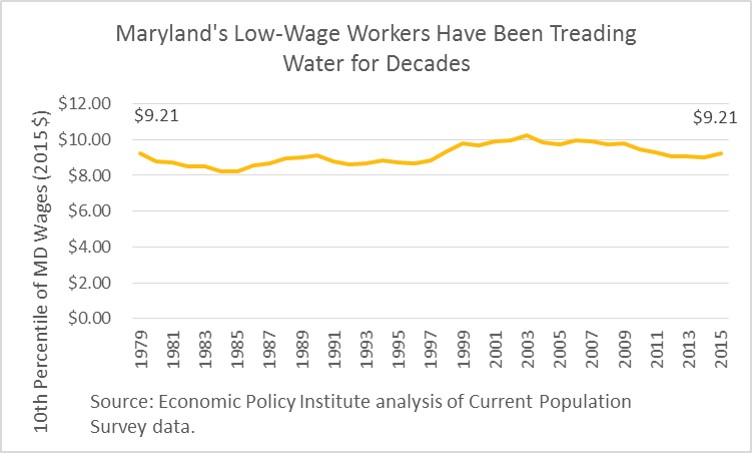Raising Local Minimum Wages to $15 Brings Big Benefits, Statewide Action Would Do More
Despite several years of modest growth since the Great Recession, the benefits of our state’s improving economy are still out of reach for the majority of Marylanders. Since 2007, hourly wages for a typical Maryland worker have failed to keep up with inflation, and the lowest-paid workers have seen the purchasing power of their hourly wages fall by more than 7 percent, as of 2015. In fact, hourly pay for low-wage workers has not grown by a single cent since 1979, after adjusting for inflation. One reason why so many working people are falling behind at a time when incomes for the wealthiest are soaring is the failure of the minimum wage to keep up with the rising cost of living. Raising the minimum wage would put more money in the hands of people who are now working but struggling to get by on low wages, which would mean stronger sales at local businesses and a healthier Maryland economy.
Baltimore City and Montgomery County—two parts of our state in which families face an especially high cost of living—are poised to make progress on the minimum wage this year. This week the Montgomery County Council voted to increase the local minimum wage to $15 by 2020 for most businesses, and 2022 for smaller businesses. The bill is now on the desk of the county executive. The Baltimore City Council is also expected to consider a similar measure to raise local minimum wages to $15 per hour over multiple years.
These measures would also enable tipped workers to earn the same minimum wage as everyone else, and ensure that the wage floor keeps pace with the cost of living in the future. If passed, these measures would bring benefits to tens of thousands of people by enabling workers to better afford necessities like food and housing and boosting sales at local businesses.
According to an analysis by the Economic Policy Institute, a similar measure considered last year in Baltimore would have raised wages for 98,000 workers, or more than one in four in the city. While this year’s bill would phase in more slowly, with the minimum wage not reaching $15 until 2022, the two measures are otherwise similar. Nearly all the workers expected to benefit from the bill are adults, many with families to support, contrary to the stereotype that portrays minimum wage workers as teenagers working part-time for extra spending money. Women and people of color are projected to see especially large benefits from a higher minimum wage in Baltimore.
When the minimum wage is increased in a measured way, as proposed, evidence shows it does not increase unemployment. The most high-quality economic studies on the effects of raising the minimum wage find that doing so does not significantly cost jobs. In fact, by reducing employee turnover and putting more money in consumers’ hands, raising the minimum wage can benefit our state’s economy. A 2015 poll of small business owners nationwide found that 60 percent favored raising the national minimum wage.
Efforts to raise the minimum wage to $15 per hour in Baltimore City and Montgomery County are an important step forward, but ultimately we need action at the state level to ensure that all Maryland workers see the benefits of a growing economy. Across our state, 123,000 people have a job but still struggle to afford necessities, according to data from the American Community Survey—in addition to many more people in these workers’ families. Even in the lowest-cost parts of the state, the eventual minimum wage under current law—$10.10 per hour, beginning in July 2018—isn’t enough to afford a basic standard of living, even for a single adult with a full-time job and no kids. To ensure that our state’s economy benefits everyone, not just those at the very top, legislators should raise the floor on wages for all Marylanders.

